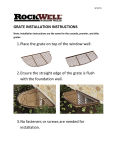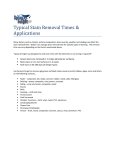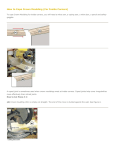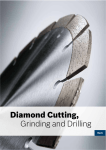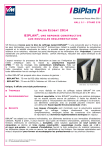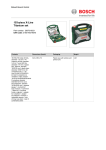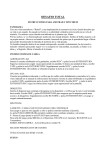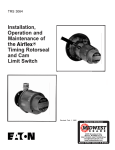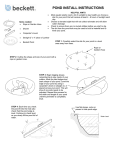Download Site Installation Manual Grated Trench Drains ACO DRAIN
Transcript
Grated Trench Drains O TT OIN AIL J T ION DE NS R’S A P E EX GINE EN TE RE C ON C E AY DD L ING BE ACO DRAIN Site Installation Manual Polymer Concrete Drain Systems R Getting Started ACO Drain consists of a full range of modular channels with lockable grates; Systems include pits, end caps, and other accessories. When installed correctly, ACO Drain products are designed to withstand a variety of loadings as classified by AS 3996 (standard for access covers and grates). Contents Getting Started 2 Health and Safety 3 Installation Sections 4 1. Excavation 7 2. On-Site Fabrications 8 3. Pipe Connections 9 4. Connection with Underground Piping Typical equipment necessary for installation may include: • Excavating equipment • String-line and laser level • Measuring tools • Masonry drill, diamond holesaw, grinder and/or saw • Rubber mallet • Concrete - 25 MPa minimum compressive strength • Gloves, respirator and eye protection 10 5. Positioning of Channels - Patty Method - Hanging Method 11 12 6. Pouring Concrete 13 7. 14 15 15 Pavement Finishing - Concrete - Asphalt - Pavers Polymer concrete products should be handled with care as they can be damaged by impact from other products, or machinery. 8. Fit Grates 16 9. Final Inspections 18 10. Maintenance 19 www.acoaus.com.au Grated Trench Drains Health and Safety Polymer concrete products are manufactured using synthetic resin, mineral aggregates and curing agents. Grates made from metals are either cast or fabricated. Main hazards include: • Abrasive damage to hands. • Inhalation of dust from grinding, cutting, or drilling. • Grinding, cutting, etc. may project small fragments. Main hazards include: • Abrasive damage/cuts to hands. • Inhalation of dust from grinding or cutting. • Grinding, cutting, etc. may generate sparks; flammable items should be removed from area. Gloves, eye protection and a respirator should be worn to avoid these hazards. Male Female Gloves, eye protection, and respirator should be worn to avoid these hazards. Operations should be conducted away from areas of fire or explosion hazard. Female female end (upstream) male end (downstream) Flow direction indicator arrow Channel sequence number Make sure arrows moulded on sides of channel all point in the intended direction of flow (outlet point). www.acoaus.com.au Installation Sections An installed ACO Drain System should incorporate the following: • Correct grate type. • Correct channel type and size. • Minimum grade 25 MPa compressive strength cement concrete surround. It is recommended that the cement concrete surround be durable and conform to minimum strength requirements, shown in the illustrations. These illustrations are a guide for average ground conditions only. If more than one pour is cast for the concrete surround, they must be adequately bonded to each other. This is for structural continuity. Refer to www.acoaus.com.au/ install_drawings_drain.htm for other installation scenarios. Expansion joint to engineer’s details Concrete AS 3996 Class A - B Concrete Bedding layer 100mm Soil 100mm Asphalt 100mm Asphalt AS 3996 Class A - B Base course Concrete Road course Bedding layer 100mm Soil Specific site conditions may require an increase in these dimensions or reinforcement. 100mm Pavers It is the customer’s responsibility to ensure the concrete Paving sand encasement is designed for the Bedding layer application. 100mm Pavers AS 3996 Class A - B Concrete If in doubt, seek further engineering advice. 100mm Soil 100mm 100mm www.acoaus.com.au Grated Trench Drains Concrete AS 3996 Class C - D Expansion joint to engineer’s details Concrete Bedding layer 150mm Soil 150mm Asphalt AS 3996 Class C - D 150mm Asphalt Base course Concrete Road course Bedding layer 150mm Soil Pavers AS 3996 Class C - D 150mm 150mm 150mm 150mm Pavers Paving sand Bedding layer Concrete 150mm Soil www.acoaus.com.au Concrete AS 3996 Class E - G Expansion joint to engineer’s details Concrete Bedding layer 200mm Soil Asphalt AS 3996 Class E - G 200mm 200mm 200mm 200mm 200mm 200mm Asphalt Base course Concrete Road course Bedding layer 200mm Soil Pavers AS 3996 Class E - G Pavers Paving sand Bedding layer Concrete 200mm Soil www.acoaus.com.au Grated Trench Drains 1 Excavation Excavate trench to accommodate drain system. Excavations must be made about the centre line of proposed drainage run and pit. Trench must be big enough to accommodate each of the following: A. Channel/pit width and depth dimensions. C. For sloped and stepped systems, excavate base of trench to roughly follow fall of trench run. B. Concrete surround dimensions. See table below for recommended dimensions ACO Drain channel Sloped system Finished surface 10, 9, 8, 7, 6, 5, 4, 3 Stepped system x 030, 030, 030, 020, 020, 020, 010, 010 x Neutral system x Trench profile Formwork if required Concrete Surround Dimensions* (x) Load Class X A - B 100mm C - D 150mm E - G 200mm * Specific site conditions may require an increase in these dimensions or reinforcement. It is the customer’s responsibility to ensure the concrete encasement is designed for the application. Engineering advice may be required. 010, 010, 010, 010, 010, 010, 010, 010 NOTE: Check product literature for overall product depth. Add additional measurement for concrete surround from table at left. Ensure loose material is removed from trench and base is compacted. Run string line, or laser, at finished surface level along full length of proposed trench run to ensure the drainage run is installed at the correct grade. In concrete pavements ensure an allowance is made for expansion/isolation joints, if necessary, to allow movement due to expansion/contraction. www.acoaus.com.au 2 On-Site Fabrications When cutting channels and/or grates, gloves, protective eye wear and respirator or mask are recommended. Cutting channels is required to form mitres, tee junctions and non-standard lengths. Fabrications can be completed on site. Channels should be cut with a masonry or diamond disc saw. Grates should be cut with band saw, or similar, with suitable blade. Mitres Mitred joints are formed by cutting channels to required angle and butting together. For heavy duty applications, mitred grates are not recommended. A tee joint is suggested to give grate maximum support. Channels mitred at 45° angle Channels are mitred; grates are shown as tee joint. Tee Junctions Tee junctions are when an opening is cut into the side of one channel and another channel is butted up to this opening. A 2-part polymer concrete repair kit (ACO Tuffstick) or a suitable proprietary sealant/adhesive can be used to bond cut surfaces together, if required. Mark area in channel wall to be removed by butting channels together and marking profile of interior of channel. Edge rail should be left intact to provide additional strength and seating for grate. If corrosive liquids are transported in trench, joints should be properly sealed. Ensure the sealant/adhesive used is chemically resistant. www.acoaus.com.au Grated Trench Drains 3 Pipe Connections Removal of preformed drill-outs, or cut hole: 1. Identify and mark area to be removed. Holesaw Holesaws are available to assist with pipe connections. 2. Remove drill-out. 90mm 99095 100mm 99120 125mm 99150 150mm 99170 To Suit Pipe Sizes Stitch Drill • Using approximately an 8mm masonry drill bit stitch drill around the preformed drill-out or marked hole/slot. (Bracing may be required) SDS Plus Arbour Part Number 99200 • Using correct size diamond holesaw, remove channel/pit wall/base to fit pipe. (Bracing may be required). • Remove the remaining fins using a hammer and a sharp cold chisel. 3. A grinder may be used to dress or enlarge hole for proper pipe or channel insertion. 4. A pipe may be fitted into hole using proprietary sealant/adhesive. If corrosive liquids are transported in trench, ensure sealant or adhesive is chemically resistant. CAUTION: Do not hammer directly on material to make penetration or remove drill-out. This may cause severe cracking of material surrounding hole. www.acoaus.com.au 4 Connection with Underground Piping Channels may be connected directly to underground piping via: 1. End cap outlets (horizontal outlet). 4. Universal Junction Pit 2. Vertical drill-outs (penetrations on underside of channel). Cut out guides are featured on sides of in-line pits and the universal junction pit for channel connection at depths and widths corresponding to different channel systems. Using a masonry or diamond disc saw, cut at required channel depth and remove wall. Smooth edges with grinder and seal joint with flexible sealant. 10 3. In-line pit. www.acoaus.com.au Grated Trench Drains 5 Positioning of Channels Start with outlet point. Ensure string-line, or laser is set at top edge of required channel height. For KlassikDrain K100 System - K31 to K60 channels are supplied in two pieces, a base channel and an extension piece. Install base channel at 180mm below the required height then position the extension piece on top of the base channel. Common methods of positioning channels include: 1. Patty Method 2. Hanging Method Male Female As per table (pg. 7) d) Lower channel vertically onto patties’ and position to correct height and alignment ensuring ‘tight’ connection to previous channel. Concrete key 1. Patty Method a) Set pit (or outlet channel) on bed of concrete to required height (see page 7 for concrete dimensions). Connect and seal outlet pipe. b) Using stiff/wet mix concrete, create ‘patties’ at intervals to support channels. Allow two patties per channel, spaced such that no concrete material is trapped in the joint, creating gaps. Note: Patties should be sized to provide required concrete surround (see page 7). c) If channels are to be sealed, roughen ends and use a flexible sealant - check chemical compatability, if required. Avoid concrete/dirt at joint e) Add concrete on top of ‘patty’ to cover concrete ‘keys’ on side of channel - this prevents movement, or floating, during concrete pour. f) Continue to lay channels until end of run or next pit is reached. IN RA OD AC AC RA OD AC IN IN RA OD Work away from outlet www.acoaus.com.au 11 5 Positioning of Channels - Hanging Method Hanging is often used in retrofit installations as existing slab provides good anchor for supports. Alternatively, formwork can be used for support. 2. Hanging Method - PowerDrain Only S100K, S200K, S300K, will require M10 - 1.5 x 120mm bolts to screw into widgets in edge rail of channel. This allows the bolt to pass through the spacers, 2 x 4’s and into widget nut. Widgets in edge rail a) Cut 2 x 4’s of appropriate width to span excavated trench or formwork (minimum 2 per channel - S200K, S300K will require 3 - 4 per channel). Cut ‘spacers’ to ‘lift’ supports above finished level - one per hanging 2 x 4 12 b) Drill two 16mm diameter holes aligned with the widgets in the 2 x 4’s and spacers. c) Using M10 - 1.5 x 120mm bolts with washers, bolt 2 x 4 and spacer to channel - do not overtighten. If using torque wrench do not set higher than 20 Nm. 2x4 supports Spacer Anchoring fasteners to prevent floating Retrofit installation Spacers allow concrete surface finishing d) Lower channels into excavated trench, adjust to required position and height. Packing material may be required beneath 2 x 4’s to achieve required height and to ensure channels are level. e) If channels are to be sealed, roughen ends and use a flexible sealant - check chemical compatability, if required. f) Nail or bolt 2 x 4 supports securely to slab/formwork. This ensures channels are held securely during concrete pour. Saw cut 2 x 4 (anchoring fasteners to prevent floating) Finished height New installation www.acoaus.com.au Grated Trench Drains 6 Pouring Concrete Channel Bracing To prevent channel wall and joints from distortion by weight of concrete, grates or plywood sections (cut to create a snug fit) should be placed in the grate rebate of channel. If grates are used, they should be suitably protected from concrete contamination during concreting (wrapped in plastic or masking tape) and should be laid to bridge channel joints to aid alignment. Shims (or washers) should be placed along one side to maintain a clearance gap. Shim Concrete Pour To prevent concrete from filling channel body, cover open areas with plywood or similar. (Bracing should suffice). Concrete should have compressive strength of minimum 25 MPa. If using hanging method, once channels are securely in position, first concrete pour should come approx. 50mm up sides of channels. Second pour First pour Once concrete ‘patties’ or first pour has set, remaining concrete surround can be poured. Concrete should be poured evenly (both sides of channel) and carefully to avoid dislodging channels. A wand type vibrator should be used to ensure concrete distributes evenly underneath and around channels. If ‘cold joints’ are a concern, engineering advice should be sought to determine alternative details. www.acoaus.com.au 13 7 Pavement Finishing - Concrete To finish installation, trowel concrete flat and taper down to channel edge. The top of adjacent pavement must be above the grate level (approximately 3mm), this ensures all liquids drain into the channel. Approx. 45° 3mm Grate Finished concrete to have slight slope down to channel Once concrete has set, remove bracing and/or grate protection. Fit grates - see pages 16 & 17. Concrete 14 Expansion joints Transverse joints (cutting across channel haunch and base) to prevent surface cracking in the slab may be required. Ideally, such joints should be positioned at channel joints. Alternatively, a cut may be made at the appropriate location along the channel and sealed with flexible sealant. Longitudinal expansion/isolation joints should be continuous and flexible. They must be provided between the concrete surround and surrounding slab and may be varied to suit concrete surround width by up to a metre from the channel. Flexible material at channel joint Expansion joint Original slab Transverse Joint If the joint is dowelled, debonding should be provided. ACO recommends seeking engineering advice. www.acoaus.com.au Grated Trench Drains 7 Pavement Finishing - Asphalt For applications up to Load Class D, asphalt can be applied directly up to channel edge. See page 7 for concrete haunch details. Approx. 45° Area should be protected between concrete pour and application of asphalt as channel edge could be damaged. CAUTION: When rolling asphalt, care should be taken not to damage channel edge or grate. 3mm Grate Finished asphalt to have slight slope down to channel Base Course Asphalt must be above grate level by approximately 3mm, this ensures all liquids drain into channel. Concrete Once pavement is finished, remove bracing and/or grate protection. Fit grates - see pages 16 & 17. Pavement Finishing - Pavers For applications up to Load Class D, pavers can be installed up to channel edge. See page 7 for concrete haunch details. Pavers adjacent to channel MUST be fully bonded to concrete haunch. This prevents movement of pavers and possible damage to channel. Subsequent pavers can be bedded on compacted sand. 15 First course bonded to concrete haunch 3mm Grate Pavers must be above grate level by approximately 3mm, this ensures all liquids drain into channel. Once pavement is finished, remove bracing and/or grate protection. Fit grates - see pages 16 & 17. Concrete www.acoaus.com.au 8 Fit Grates Grate removal tool QuickLok Grates Used on KlassikDrain grates, QuickLok provides secure boltless locking, which is quick to remove/replace for maintenance and cleaning. QuickLok bars 1. Locate locking bar in the channel wall recesses by rotating clockwise. K100 K200 K300 2. K100 - Use hammer to tap bar into place, so that the serrated ends grip in recess. K200/K300 - Push plastic clips forward to lock bar into position. 4. To remove grate, insert grate removal tool under grate bar and pull up sharply. Once first grate is removed, remaining grates can be removed by hand. Grip end of grate and lift sharply (use gloves). 16 3. To install QuickLok grate, align stud directly over locking bar. Push down or stand on grate until it clicks into position. 5. K100 - To remove bar, insert screwdriver into holes at ends of bar and lever back serrated end, which should then come free. K200/K300 - Push plastic clips back to unlock, rotate bar free. www.acoaus.com.au Grated Trench Drains 8 Fit Grates PowerLok Grates Used on PowerDrain (S100K/S200K/S300K), PowerLok provides secure locking using the ACO grate removal tool. Grate removal tool 13m m 1. To open: slip flat end of grate removal tool into the slot between PowerLok mechanism and edge rail as shown. 3. Slide grate removal tool into grate and lift first grate out, subsequent grates can be removed by hand. 2. Rotate the tool through 90˚ until lock mechanism slides across and clicks open. Repeat for each lock (2 per grate). 4. To close: Fit one side of grate under lugs in channel rail and lower grate into position. Use hook on grate removal tool to push the clip back towards closed position, until a click is heard. Repeat for all locks. 17 www.acoaus.com.au 9 Final Inspections Final Inspections 1. Remove any debris in system and grate rebate. Ensure outlet pipes are clear. 2. Install rubbish baskets in pits, if required. 3. Flush trench run to check for pipe work blockages, unblock if necessary. 4. Empty rubbish baskets and clean out pipe connections, if necessary. Replace rubbish baskets. 5. Install grates in proper position ensuring they are securely locked down (pages 16 & 17). Drainage system is now ready for use. 18 www.acoaus.com.au Grated Trench Drains 10 Maintenance Maintenance Regular inspections of trench drain system are recommended. Frequency will depend on local conditions and environment, but should be at least annually. Inspections should cover: • Grates and locking devices • Pits and rubbish baskets • Concrete surround and adjacent paving All items should be inspected for damage, blockage or movement. Compare with site drawings if necessary. 1. Remove grates - see pages 16 & 17. 2. Remove debris from channel. 3. Flush channels with water or high pressure washer. 4. Repair damaged surfaces, if necessary, with an appropriate ACO repair kit. 5. Renew joint seals as required. 6. Empty rubbish baskets and clean out pipe connections. 7. Re-install rubbish baskets. 8. Re-install grates, ensuring they are locked in place. Systems with grates that have wide slots may be cleaned with the use of pressured water applied through the grate — debris will be washed to pits for removal. (Empty and replace rubbish basket). www.acoaus.com.au 19 Other ACO Product Lines ACO Cablemate A range of electrical and communication cable jointing pits and surface ducting systems. ACO DRAIN A range of grated trench drainage systems and pits made from ‘Polycrete’ polymer concrete. Grates are available in various materials and finishes for all loadings. ACO Access A range of ductile iron, galvanised steel and composite access covers in a wide range of sizes and configurations from single to large multi-part units. ACO Stainless A range of high performance stainless steel drainage channels, grates, floor drains and pipes for hygiene and aesthetic applications. ACO Sport A complete range of surface drainage systems and ancillary products for sport fields, running tracks and stadiums. ACO Home An range of economical domestic drainage products, ideal for homes, gardens and landscaped areas. ACO Polycrete Pty Ltd ABN 65 050 102 942 www.acoaus.com.au Sales Hotline Telephone 1 300 765 226 Facsimile + 61 2 4747 4040 Email [email protected] Technical Services Hotline Email [email protected] NSW and Head Office 134-140 Old Bathurst Rd Emu Plains NSW 2750 Australia Telephone +61 2 4747 4000 Facsimile + 61 2 4747 4060 QLD Office 467 Tufnell Road Banyo QLD 4014 Telephone (07) 3267 8700 Facsimile (07) 3267 8711 [email protected] VIC Office 9 Overseas Drive Noble Park VIC 3174 Telephone (03) 9795 3666 Facsimile (03) 9795 6444 [email protected] South Australia Telephone 1300 765 226 [email protected] Western Australia Telephone 1300 765 226 [email protected] Northern Territory Telephone 1300 765 226 [email protected] © March 2008 ACO Polycrete Pty Ltd. All reasonable care has been taken in compiling the information in this document. All recommendations and suggestions on the use of ACO products are made without guarantee since the conditions of use are beyond the control of the Company. It is the customer’s responsibility to ensure that each product is fit for its intended purpose and that the actual conditions of use are suitable. ACO Polycrete Pty Ltd reserves the right to amend products and specifications without notice.




















